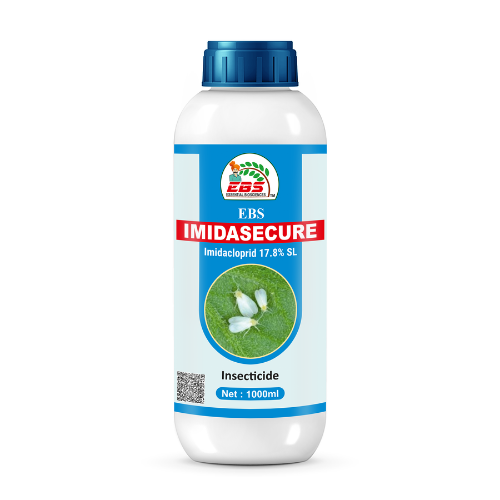| Brand | : Essential Biosciences. |
|---|---|
| Data | : Tricyclazole 75% WP Systemic Fungicides |
| Availability | : In Stock |
Available Options
-
Tags:
EBS Bhoogol Tricyclazole Systemic Fungicides , Tricyclazole 75% WP Fungicides , Wettable Powder , Rice Blast Pyricularia oryzae controller , Leaf spot controller , Fruit rot , Late and Early blight , Downy mildew fungus controller , control nack blast of paddy , EBS , Krishibazaar Insecticides , Essential Biosciences
EBS Bhoogol Tricyclazole 75% WP Systemic Fungicides:
Tricyclazole 75% WP is a pesticide formulation used in agriculture to control and manage fungal diseases in crops. Here's a breakdown of the product description:
Active Ingredient: Tricyclazole: This is the primary active ingredient in the formulation, constituting 75% of the entire product. Tricyclazole is a chemical compound known for its fungicidal properties, particularly its effectiveness against certain types of fungi that affect crops.
Formulation Type: WP stands for Wettable Powder. It is a type of pesticide formulation where the active ingredient (tricyclazole) is finely ground and mixed with inert materials to create a powder that can be easily dispersed in water. This allows for the preparation of a suspension that can be sprayed onto crops.
Concentration: Tricyclazole works by inhibiting the growth and reproduction of fungi. It interferes with the development of fungal cell walls, disrupting their structure and preventing further growth. This mode of action helps control and prevent fungal diseases in crops.
Mode of Action: The wettable powder formulation allows easy mixing with water to create a spray solution. It can be applied using conventional spraying equipment, ensuring thorough coverage of the plant surfaces
Application: The product is meant to be mixed with water to create a sprayable solution. Farmers or applicators can use conventional spraying equipment to apply the mixture to crops, covering them with the fungicidal protection provided by tricyclazole
Disease Control: Tricyclazole is effective against various fungal diseases, including those caused by certain types of fungi such as Pyricularia oryzae, which causes rice blast disease.
Precautions and Directions for Use: The product will likely come with specific instructions for application, dosage, and safety precautions. Users should carefully follow these guidelines to ensure effective and safe use.
Recommended crop: Tricyclazole 75% WP is commonly recommended for the protection of certain crops, especially those susceptible to fungal diseases. The primary target crops for Tricyclazole include:
Rice: Tricyclazole is widely used to control fungal diseases in rice crops. It is particularly effective against rice blast disease caused by the fungus Pyricularia oryzae. Rice blast is a significant concern in rice-growing regions, and Tricyclazole helps manage and prevent its occurrence.
Wheat: Wheat is another crop for which Tricyclazole may be recommended. Fungal diseases such as leaf and stem rust and other pathogenic fungi can affect wheat crops. Tricyclazole's fungicidal properties help protect wheat plants from these diseases.
Barley and Other Grains: Tricyclazole may also be used on other grains, including barley and similar crops, to control fungal infections that can threaten crop yield and quality.
Other Crops: While rice, wheat, and barley are among the primary crops, Tricyclazole may have applications for other crops susceptible to fungal diseases. The specific crops may vary based on regional agricultural practices and the prevalence of particular fungal pathogens.
Target Disease:
Tricyclazole 75% WP primarily targets fungal diseases in crops. The most notable and common target disease for Tricyclazole is:
Rice Blast (Pyricularia oryzae): The primary and most well-known target disease for Tricyclazole is rice blast, caused by the fungus Pyricularia oryzae. Rice blast is a devastating disease affecting rice crops, leading to significant yield losses if not effectively managed. Tricyclazole is particularly effective in controlling and preventing rice blasts by inhibiting the growth and development of the fungus.Tricyclazole's mode of action involves interfering with the biosynthesis of melanin in the fungal cell walls, which is crucial for the growth and structural integrity of the fungus. By disrupting this process, Tricyclazole helps to control the spread of the disease in rice fields.
Methods Of Application and Dose:
Mix Tricyclozole 75% well in the prescribed quantity of water and spray on plant leaves or infected areas.
How to use : The application of Baan in the nursery is subject to the appearance of blast symptoms. After transplanting, the first application against leaf blast should commence at the tillering stage & second at the 5% panicle emergence stage for effective control of blast disease.
Dose : 12 gm in 15 litter Water, 120 gm/ acre.














0 Review For This Product